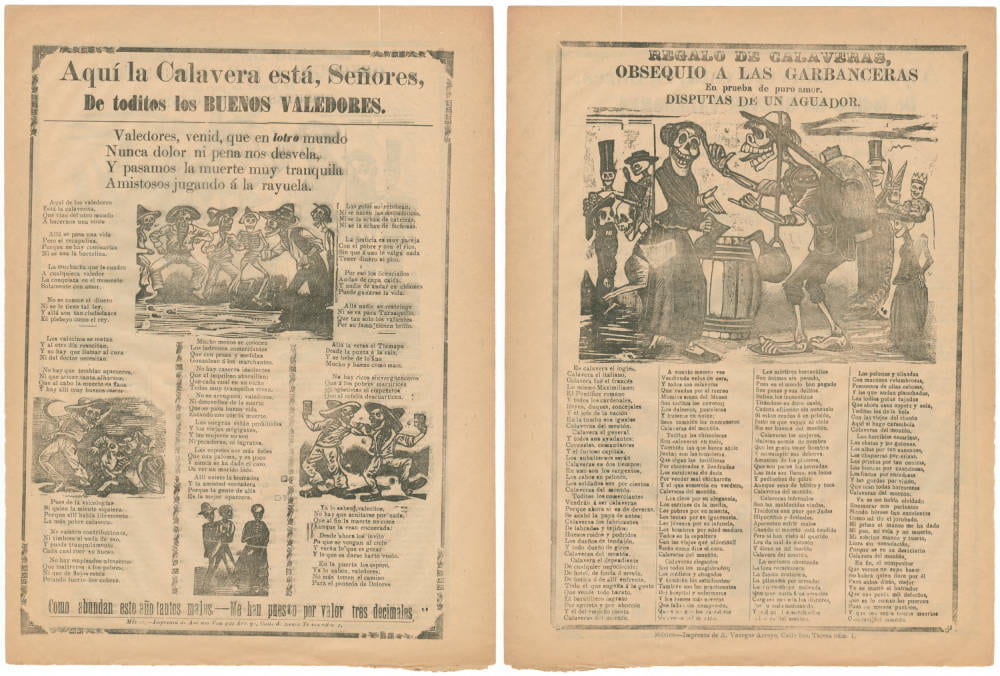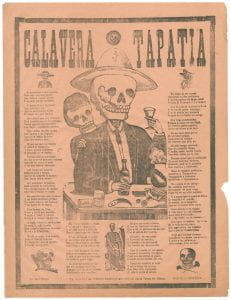
Gentlemen, the skeleton of all the good protectors is here (1913)
“The air is cool, the season fall, soon Halloween will come to all…” This week brings October to a close and with that my favorite holiday of the year is fast approaching. Halloween, All Hallows’ Eve, or All Saints’ Eve, is celebrated in many countries on October 31st. It is a time dedicated to remembering the dead, including saints (hallows), and martyrs. Halloween is immediately followed by Día de los Muertos, The Day of the Dead. Celebrated nationally on November 1st in Mexico and elsewhere, the Day of the Dead is also named All Saints’ Day and All Souls’ Day. This holy day involves family and friends gathering to pray for and remember friends and family members who have died, building offrendas and helping support their spiritual journey.
In the DeGolyer Library’s holdings is a substantial collection of Mexican broadsides illustrated by the artist José Guadalupe Posada. This Mexican printmaker is considered the “Father of Modern Mexican Art” and also “printmaker to the Mexican people.” To view this influential artist visit the DeGolyer Library’s digital collections.

José Guadalupe Posada (1852-1913) was born in Aguascalientes, Mexico. He is most known for his broadsides featuring Calaveras, skulls and skeletons. These works portrayed daily lifestyles, the abuses of government, and the exploitations of people sometimes using skeletons. Following Posada’s death, these works became associated with the holiday Día de los Muertos. Most of Posada’s prints were published by Antonio Vanegas Arroyo in the form of inexpensive news sheets and corridos (Mexican ballads about struggle against oppression and injustice) sold in markets and aimed at the lower class and illiterate.

1910
The DeGolyer Library also holds photographs by image makers working in Mexico such as Alfred Briquet, Hugo Brehme, Charles B. Waite and others. There are photographs of the Mexican Revolution by Manuel Ramos, Walter Horne, and other photographers throughout Mexico and on the border. The Elmer and Diane Powell Collection on Mexico and the Mexican Revolution is an important resource for the study of Mexico. The Powell collection consists of photographs, real photographic postcards, Posada prints, original artwork, broadsides, currency, periodicals, books and manuscripts related to Mexico and the Mexican Revolution.

Want to learn more about Posada and other “haunting” images in the archives? Then be sure to register for the upcoming Archive’s Month panel: Spooky in Special Collections.
Join six wonderful Texas institutions starting at 1:30pm CT on Friday, October 30 for a live, virtual event on Zoom as we share and answer questions about some of the spookiest items from each of our collections. It’s sure to get you in the Halloween spirit!
Registration is free, but required to attend and participate so don’t delay! Register today!
Schedule of the featured repositories presentation times, All times listed are for Central Time Zone.
- 1:40pm DeGolyer Library, Southern Methodist University
- 2:00pm Texas Christian University
- 2:25pm Texas A&M University
- 2:45pm University of Texas El Paso
- 3:10pm University of North Texas
- 3:30pm University of Texas San Antonio